#temp probe griddle
Explore tagged Tumblr posts
Text
Temperature probe griddle 41100-17 Temp probe Griddle 4110017 worldwide delivery
Qty 12pieces
Cost USD100 for 1pc on minimum purchase of 6pieces
We sale all types of temperature Probe worldwide
IDEAL DIESEL MARINE
E-MAIL: [email protected] (Primary)




#Temperature probe griddle 41100-17 cost USD100-Temp probe Griddle 4110017 worldwide deli Qty 12#Temperature probe griddle#Temperature probe griddle 41100-17 cost USD100-Temp probe Griddle 4110017#Temperature probe griddle 41100-17 cost USD100-worldwide deli Qty 12#41100-17#temp probe griddle#griddle temp proble 41100-17
0 notes
Text
Char-Griller E16620 Akorn Kamado Charcoal Grill Review & Test

Today, we turn the heat up on one of the popular choices in the market - the Char-Griller E16620 Akorn Kamado Charcoal Grill. Designed to offer the perfect balance of high-heat grilling and low and slow cooking, this product has created a stir among grill enthusiasts. In this comprehensive review, we will dive deep into its design, performance, and key features such as its large cooking area, triple-walled steel insulated design, and the much-touted easy-to-use and clean functionalities. Char-Griller E16620 Akorn Kamado Charcoal Grill Features Ease of Use and Versatility The Char-Griller E16620 Akorn Kamado Charcoal Grill has been a game-changer in my grilling experience. I initially bought it because I wanted to experiment with a variety of slow and low cooking techniques. Its dual adjustable dampers and easy dump ash pan make it a breeze to control and manage during long cookouts. One of my favorite creations is smoking a rack of ribs for several hours. The controlled heat and smoke impart an incredible depth of flavor that can't be matched. High Quality and Performance Having cooked on this grill numerous times, I can attest to its superior performance. The cast iron grill grates and triple-walled steel construction retain heat exceptionally well. This makes it possible to sear meats at high temperatures, locking in juices and creating a delicious crust. One unforgettable experience was grilling a whole cedar-cooked salmon - the fish turned out moist and smoky, with the subtle cedar undertones taking it to a whole new level. Durability and Value After six years of using a small Akorn char griller, I upgraded to the large model. Despite constant use, the small Akorn maintained its top performance and durability. The steel construction and powder-coated exterior stood up to the elements well. My large Akorn grill continues to deliver the same excellent results. Its value is outstanding, providing features and capabilities comparable to more expensive Kamado grills. Additional Features and Accessories The Akorn Kamado grill is more than just a grill - it's a complete outdoor cooking solution. I've bought several accessories for it, such as a plate for indirect cooking and Therma-Pro wireless probes to monitor grill and meat temps. The folding side shelves provide space for prep and are equipped with hooks for my tools, keeping everything I need within arm's reach. After several years of owning and cooking on the Char-Griller E16620 Akorn Kamado Charcoal Grill, I can confidently say it's one of the best grills I've used. Whether I'm cooking for a small family dinner or a large gathering, this grill delivers consistent, high-quality results every time. It's a great investment for anyone passionate about outdoor cooking. Final Thoughts We know that choosing the perfect grill can be overwhelming, considering the multitude of options out there. However, we're here to help. We've done the hard work for you by researching and analyzing numerous models across categories. Let's find a grill that suits your needs and budget: - Best 5 Burner Gas Grills: These grills provide ample cooking space and high heat output for large gatherings or multi-dish cooking. We've compiled the top picks in this category for you. - Best Affordable BBQ Grill: Quality doesn't always have to break the bank. Our selection of budget-friendly BBQ grills offer excellent performance without putting a huge dent in your wallet. - Best Budget Grills: If you're on a budget but still looking for a reliable and efficient grill, these options are worth considering. We've identified a few models that are economical without compromising on quality. - Best Gas Grill and Griddle Combo: Can't decide between a grill and a griddle? Why not have both! Check out our recommended models that offer the versatility of grilling and griddle cooking in one unit. - Top Grill for Pontoon Boat: Love to grill while out on the water? These grills are designed to mount onto your pontoon boat for a great grilling experience while cruising. Remember, the best grill for you depends on your unique needs, preferences, and budget. Happy grilling! Read the full article
0 notes
Text
Cheap, low spoon cooking
My cooking tends to start with protein, and because of my food issues, that protein is generally meat, and if you argue with me about that, I’ll block you, because if you want to do a thread on low cost vegan cooking, go right ahead, you’ve got your own blog right there. Holler if you want more specific instructions for any of these, and let me know whether you just need a basic recipe or “how to for a complete noob to the kitchen” or anything in between.
1. Chicken
Chicken is at the top of the list for cheap and easy, because it can often be had for less than $1.50 per pound, and because many preparations of it can be done with less than 5 minutes of work (oven time not included.)
Basic: get whole chicken. Preheat oven to 450. Pull out giblets. Sprinkle salt on skin. Roast at 450 for 1 hour. Enjoy crispy skin, tender meat. Same method (shorter cooking time, about 45 minutes) works for bone-in skin-on thighs. With the whole chicken, you can usually make one bird into several meals, by using the meat for one meal, and making soup out of the bones and whatnot for the next meal. If you get skinless boneless thighs, they’ll usually be a little cheaper than skinless boneless breasts. Don’t roast them, cut them up, drench them in a marinade, and pan fry the pieces. Serve with pasta or rice and stir fried veggies.
2. Pork
Pork tends to range in price from $2.50 per pound up to $8 per pound. I’m usually getting pork shoulder for about $3 per pound. Shoulder and “country style ribs” are incredibly cheap and can be pressure cooked (instant pot) or slow cooked into pulled pork with seasonings, or you can get slightly fancier, make a marinade of coconut aminos and orange juice (or apple juice and apple cider vinegar, or rice wine vinegar, mirin, soy sauce, whatever, just make sure there’s some salt and some acid and some sweetness in the marinade to help tenderize the meat), and cut the shoulder roast into 3/4 inch thick steaks, cutting across the grain, then put in a bag or bowl with the marinade overnight. We add onions and garlic and shallots to the marinade because I can digestively tolerate them only if they’ve been soaking in acid of some sort for a while. My favorite is to marinade in orange juice, coconut aminos, chilis, onion, garlic, etc. overnight, then pan fry the steaks, turning often, until golden brown. The resulting pork shoulder steaks get cut into strips and served a variety of ways--tacos, sandwiches, lettuce wraps, whatever. We usually use about 8 oz per person if there’s no fancy sandwich toppings, and 6 oz per person or less if making wraps or tacos. I have to have a little more energy for this method, and will often have someone else prep the aromatics.
3. Eggs Even farm eggs, if you live anywhere near a rural area, can be had for less than 50 cents an egg, and regular conventional eggs have been $2 per dozen or less basically as long as I’ve been alive. Basic egg recipes can go from fridge to table in about 5 minutes. I usually get eggs from a friend whose neighbors have backyard chickens, for about $4 per dozen. A good nonstick egg pan + eggs is a fast way to get protein into you without spending all your energy doing it. Over easy, scrambled, omelet, or my kid’s favorite, egg in the hole... all cheap and incredibly fast.
4. Beef Most beef is not cheap, and has been getting steadily more expensive for years. That said, if you understand how to cook various less fancy cuts, and shop at a local butcher, chances are you can get your meat for far less than a typical grocery store. I rarely go for things like ribeye or filet. We’re all about the round roast, chuck roast and flat iron here. Also like the shank. I rarely spend more than $7 per pound on beef, usually closer to $6. But again, we’re shopping at a local butcher who sources meat locally and does all breakdown themselves. Tricks: Look for a whole flat iron and ask the butcher to cut it. The method I ask for is “Please cut it off the silverskin and then into 6 oz portions.” This eliminates most of the gristle layer, leaving incredibly tender meat with a ton of flavor. The flat iron is from the chuck, but is a specific muscle that doesn’t get used a lot, so it’s very tender. Round roast, tip roast... these can be just salted and roasted very slowly (like, 200 F) if you have a meat thermometer with a probe that can stay in the meat, so that you roast it at very low temp until it comes up to about 110-120 degrees, then you take it out, turn the oven up to like 450, put a rub on the meat, and blast it at high heat until the probe is at 140. Then you let it rest for a while and come up a few more degrees, and what you get is a roast with a crust, as tender as the cut is likely to get while staying pink, which, cut thin, will be fantastic roast beef. If you don’t have a fancy thermometer, we usually start it high, then turn it down without opening the oven and let it go for an hour or so before checking with a cheap thermometer. But you can also cut into smaller pieces, marinade, and stir fry. You can ask the butcher to cut your roast into chunks for stir fry, if you aren’t up to the cutting.
Chuck, shank, and other tough cuts can be pressure cooked into super tender pot roast very quickly. Wine, mushrooms... We use cheap sulfite-free wine and whatever mushrooms are most affordable for this.
5. Lamb Lamb can be pricey, but we get a boneless leg roast (grass fed) at Costco for about $6 per pound, which is one of the best prices out there for grass fed meat. We use the roast in one of two ways: We either roast it low and slow like beef, serving it rare, or we cube it and pressure cook it with savory liquids and then serve it with coconut milk and curry paste over rice. So good. 6. Duck Our local Asian markets usually have whole duck for $3.50-ish per pound. It’s outrageously expensive literally anywhere else. Duck doesn’t cook like chicken, exactly... you must score the fat if you want it crispy, which means poking the fat without poking the meat. We roast at high temp, flipping as needed, to get a very crisp duck without drying out the breast. SAVE the drippings and use them in soup, or to cook eggs or potatoes in. Duck fat is like gold. So much flavor. 1 duck feeds 3 of us an indulgent amount of duck. Cooking gadgets for reducing the amount of physical energy you need to cook things: I never, ever use slow cookers because even used properly they seem to create less flavor than the pressure cooker methods. Pressure cookers are like slow cookers for procrastinators. Things that normally would take all day take an hour. Things that would take a couple of hours will take 30 minutes. The amount of money you can save in cooking beans alone vs. canned will pay for it. Pressure cooker is often the difference between me making homemade stock and throwing the carcass away. They’re also about as efficient at transferring heat into meat as any form of cooking you can get, so the energy savings are not irrelevant. Instant Pot is $70-ish at Costco right now, I’m just saying. An oven is helpful, but if you don’t have a full sized oven or can’t bend that way, a toaster oven can do a LOT. If you can get one that is large enough to cook a chicken in, you don’t need a larger oven if you aren’t doing large scale cooking. If you have a child who wants to learn to cook, a cheap toaster oven costs about the same as an EZ bake, but is an actual real kitchen device which can do real cooking. Spend a little more and get one with air circulation and a little more interior space if you can afford the counter space and the money. I know people like air fryers, I’ve not seen the point. Very few things an air fryer can do that a convection toaster oven can’t, and the form factor is better for the toaster oven for cooking a reasonable amount of tater tots. (priorities!)
Food processor: If you find chopping things a barrier, food processors can slice and grate very quickly, and rinse off nicely without a lot of elbow grease. I don’t usually bother, but I have minions who will do chop prep for me. If you don’t, even a small food processor will be less taxing on sore joints than most chopping. If you want to make pastry, a food processor is a must if you have energy issues.
Knives and a means to sharpen them: dull knives make cooking incredibly exhausting and tedious. Sharp knives make it all work so much better. The base price of the knife is less important than the condition you keep it in, as youtube will be happy to show you in a variety of mesmerizing videos.
Meat thermometer: Sort by reviews, ignore any where the reviews are suspicious. My strong preference is for digital quick-read ($10ish) OR probe-style leave-in. ($20-ish) You want this for food safety AND so that you can avoid overcooking roasts.
Cutting board: ideal is something with a groove (prevents juices from flooding the counter and contaminating everything) that runs around the edge. Cheap plastic boards can be convenient, I guess, but are harder to get reliably clean than wood, which tends to kill off germs. My favorites are bamboo. Not terribly spendy, super pretty, work very well.
The pans I use: 9x13 pyrex baking dish for most of our chicken stuff dark enamel roaster (not huge unless you’re going to do turkeys) for beef roasts (very cheap) large baking trays lined with silpats (both bought at costco, idek, they’re ideal for tater tots and such and don’t get problems with sticking and are easy to clean) Nonstick PFOA-free egg pan, sautee pan and 11 inch griddle. I think I spent $22 at Target on three egg-type pans of different sizes? Not particularly spendy, but you do need to replace them every 5 years or so. variety of saucepans and pots in stainless (I have cuisnart and Kirkland and they’re fine and last kind of forever barring disasters and sometimes even then. Can be bought second hand.) We use a lot of pyrex stuff because it’s convenient for leftovers and mise en place. If you have someone helping with chop prep, little dishes full of prepped things make the cooking go so much easier. But you can do that in regular dishes too, we’re just fancy that way (and I stg the pyrex breeds in the cupboard.)
I’ll talk starches if people want.
13 notes
·
View notes
Text
Tomahawk Ribeye Steak with Spinach and Goat Cheese Orzo
FTC Standard Disclosure: This post is sponsored by the Certified Angus Beef® Brand in conjunction with a social media campaign through Sunday Supper LLC. All opinions are my own.
I was excited as a kid at Christmas when my Food City (Morrell Road) started selling Certified Angus Beef® Brand tomahawk ribeye steaks this past Summer.
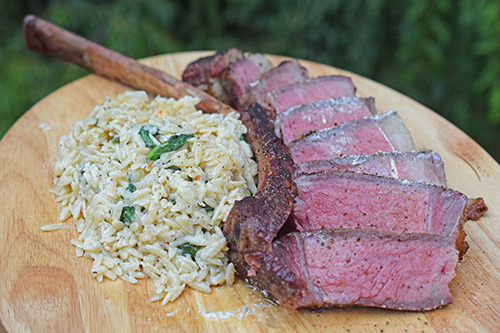
Tomahawk ribeyes are those fancy steaks with a brontosaurus-sized Fred Flintstone bone sticking out of them. They usually show up on the menu as a "steak for two" because they are often 40-50 ounces each. They also typically sport a price tag of over $100 at a steakhouse. But I bought this 3+ pound tomahawk for under $40 at Food City.
What is a tomahawk steak and how does it relate to a regular ribeye?
It's the same meat, just presented differently.
If you cut the rib bone down to where the steak meat ends, it would be a "bone-in" ribeye.
If you "french" that bone so it is exposed, it's a cowboy ribeye steak.
Cut the bone off altogether and it's the classic ribeye steak.
Typically, the cowboy and tomahawks are much thicker than your typical ribeye steak.
Because they are so thick, tomahawk steaks are a prime candidate for either a sear/roast, sous-vide, or reverse sear methods. I chose to use the reverse sear method on a kamado grill. Shocker, right?
Tomahawk Ribeye Steak with Spinach Orzo
Ingredients
40-50 ounce Certified Angus Beef® Brand tomahawk ribeye
1/4 cup NMT Beef Rub v.2 or other beef seasoning
2 teaspoons peanut, avocado, or other type of high temperature cooking oil
For the Spinach and Goat Cheese Orzo
1 cup orzo, cooked according to package directions
1 cup baby spinach, triple rinsed
1/2 cup chopped sweet onion
1/4 cup crumbled goat cheese
1 1/2 teaspoons NMT Beef Rub v.2 or other all-purpose seasoning
2 tablespoons beef tallow or high temperature cooking oil
For the Three-Chile Compound Butter
5-6 tablespoons butter, softened
1/8 teaspoon dried ancho or guajillo chile
1/8 teaspoon dried red bell pepper
1/8 teaspoon dried poblano chile
1/4 teaspoon dried shallot or onion
salt to taste, about 1/2 teaspoon
Instructions
Prepare the Steak. Pat the steak dry and lightly apply a coat of high temperature cooking oil. Season all over with beef rub. Place on a resting rack and pan then rest at room temperature for at least 1 full hour. You can go ahead and dry brine in the refrigerator for 6-8 hours before resting at room temperature.
Preheat the grill. Light the grill, set up for indirect heat, and preheat it to 250°f. We used a kamado grill set up with a full Kick Ash Basket of natural lump charcoal. I lit it in 3 spots and placed an adjustable rig with a stone for the heat deflector. As the temperature hits over 200°f, start cutting back on the lower and upper vents to "coast" up to a stable 250°f.
Slow roast the steak. Place the steak on the grill, close the lid and slow roast the steak. Monitor the internal temperature with a remote probe thermometer and cook until the steak reaches an internal temp of 123°f. This should take right at 75-90 minutes depending on the size of your steak.
Make the butter. Mix together the butter, chiles, shallot/onion, and salt. Set aside.
Rest the Steak. This part is essential to the reverse sear technique. Place the steak on a resting rack/pan and let it rest. The internal temperature will continue to rise another 5 to 7°f as part of the "carryover cooking". Keep an eye on this. When the internal temp finishes rising and started to fall, it is time to sear your steak.
Make the Orzo. Change the grill to direct heat. Place a medium sized wok on the grill and preheat. Add the tallow/oil and saute or stir-fry the onions until tender, about 5-8 minutes. Toss in the cooked orzo, goat cheese, and beef rub until combined. Remove from heat and fold in the raw spinach. The residual heat will be enough to cook the spinach through. Taste for seasoning and add salt/pepper as needed.
Sear the Steak. Open the grill vents to bring up the cooking temperature to over 500°f. If using a skillet or griddle, place it in the grill long enough to get hot (5 minutes or so). Sear the steak on both sides just long enough to get color and crust developed, about 1 minute per side.
Serve. As soon as the steak comes off, top it with some of the compound butter. Tomahawk steaks are generally meant to be shared. The best way to serve is to run a knife along the bone to remove the steak and then slice it into half-inch thick pieces.
Notes/Substitutions
NMT Beef Rub v.2 - We think that our beef rub rocks but I understand getting dried shallot isn't the easiest thing. Another good recipe that you can make is Certified Angus Beef® Brand's Signature Seasoning.
Dried chiles - We usually have a variety of chiles on hand. Ones that you might have in your spice pantry are ancho chile, red pepper flakes, or ground chipotle.
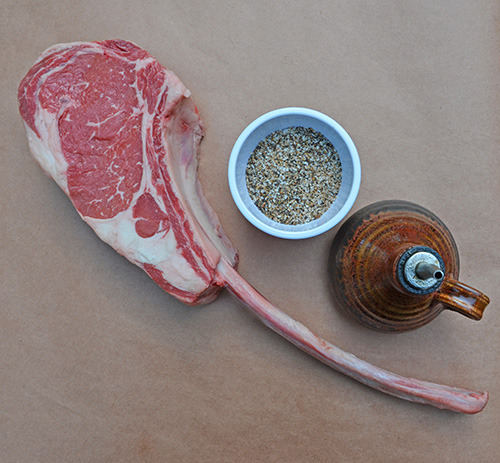
The tomahawk ribeye steak is so thick that it enters into "prime rib" territory, it's basically a 1-bone roast.
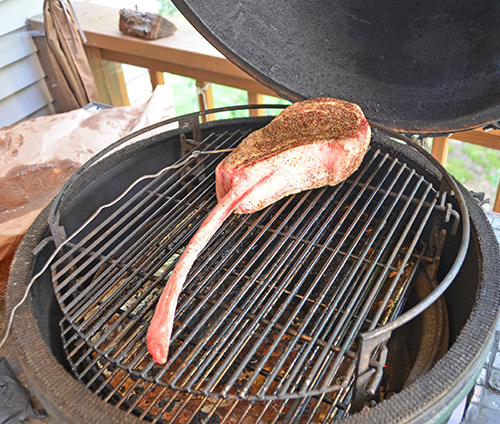
My set up was a large kamado grill, an adjustable rig with an oblong heat deflector. You could also use a standard plate setter and grill grate set up. For a kettle style grill (Weber, etc.), bank your coals to the side and grill over the empty space. For a gas grill, use one burner to keep the heat at 250f and then grill the steak over one of the burners that aren't on.

Resting the steak on a resting rack keeps from trapping the heat against a flat surface and steaming that side of the beef, causing juices to run out. Also, note that this remote probe records the max and min temperatures in the upper left corner. This feature makes it easy to know 1) what temperature the food maxed out at during the rest period (130f in this case) and 2) that the internal temperature has started to fall.
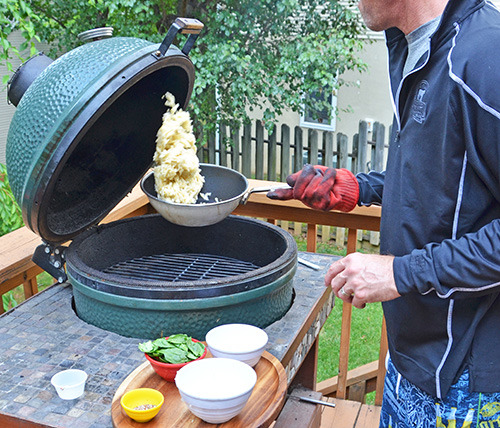
Tossing the orzo. You can also make this on the stove top, I just hate to waste a perfectly good fire while the steak is resting.

You can sear directly on the grill's grates but I like searing on a flat surface like a griddle or skillet. Here I'm just using the back side of a set of GrillGrates. The full contact with the surface of the meat creates a delicious crust.
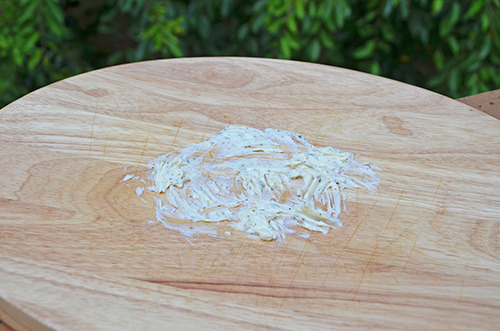
Chef Adam Perry Lang likes to use a "board dressing" on his cutting boards. It is a mix of oil, herbs, garlic, and seasonings on the board on which he will be slicing. I didn't have a board dressing but I did have a compound butter.....and compound butter is basically oil and seasonings.....sooooo instant board dressing!
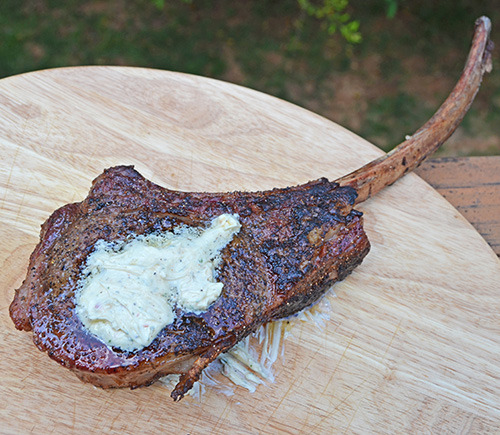
The steak resting with the compound butter on top.
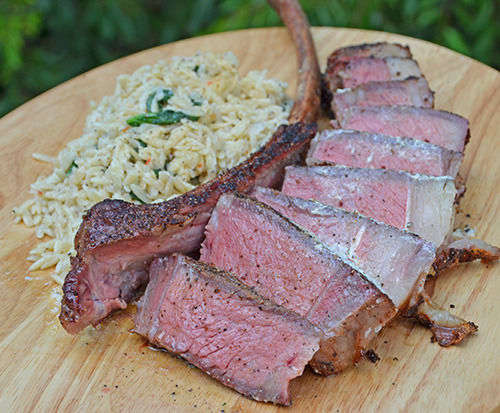
Served platter style.
What did we do with that big leftover tomahawk bone?
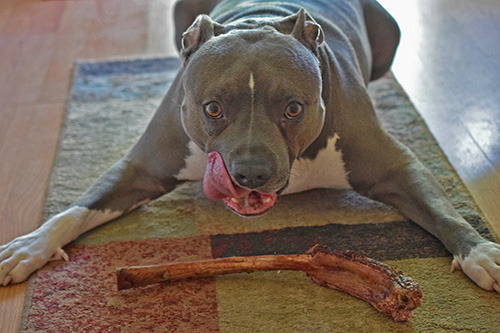
Go ahead.....YOU take it from him. [Note: Cooked bones generally aren't good for dogs as they will splinter. We let him have them long enough just to chew the meat off.]
Source: http://www.nibblemethis.com/2018/08/tomahawk-ribeye-steak-with-spinach-and.html
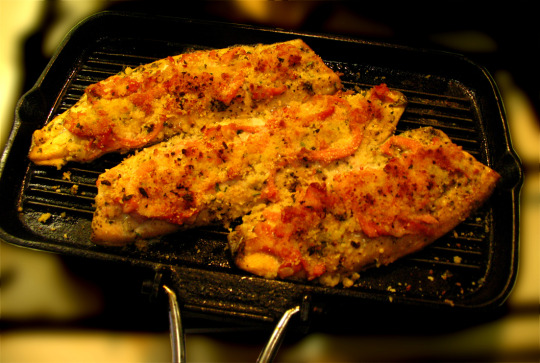
0 notes
Text
Tested: High-Tech Cooking With the Cinder Grill and Meater Thermometer
After decades of only minor changes, the last few years have brought us an onslaught of high-tech updates to traditional cooking devices. Among those have been a variety of smart ovens and connected thermometers. As someone who cooks dinner almost every night, I can both appreciate how useful more technology can be in the kitchen, but also that it can sometimes just make life more complicated. So I set out to test the Cinder Grill ($429) and Meater’s completely wireless thermometers ($69-$269) with that in mind. Would they make life easier for a tech-enthusiast cook, and would they produce better results than the devices they aim to replace?
Cinder Is a Cool Name for a Grill, but What Does It Do?
When you first see a Cinder Grill it is hard not to think of the George Foreman grill. But the Cinder is light years ahead of the Foreman. Yes, it is a grill (technically, more of a griddle or “flattop” since it has flat surfaces), but it is a high-precision and versatile version. You can dial in just about any temperature, and use either one or both cooking surfaces. Speaking of which, the surface isn’t huge, so like the Foreman, you’re constrained to how much you can cook at once. I found I could cook four eggs or four burgers at once, but either filled the entire 9-inch by 10-inch grilling surface.
Cinder Promises Sous-Vide Without the Water
I’ve been using a thermal bath and vacuum-sealed bags to help get meat and fish cooked to a precise temperature for 15 years because the results are excellent. The trick is that the water bath is held at a specific temperature so that your food can’t get hotter than that — meaning you won’t overcook or burn it. However, it’s a bit of a cumbersome process, and the resulting texture and color aren’t typically appetizing, especially for steaks. So an additional step of patting the meat dry and searing it is needed (aka a reverse sear).
The Cinder Grill provides a remarkably evenly-heated cooking surface as shown using this thermal image from a FLIR ONE Pro camera.
The Cinder grill replaces the water bath with carefully heated heavy metal plates. A set of three high-tech heating coils under both a top and bottom plate allows you to control the temperature of the grill surface precisely. At least that’s what Cinder and a control knob calibrated to the nearest degree promised. I wanted to check for myself, so I used my FLIR ONE Pro to measure the surface temperature of the grill plates when I had the control set to 350 degrees. While it wasn’t perfect, the Cinder did a much better job than most grills. The middle third or so of the lower grill was within a degree of 350 (at least as measured by the FLIR), and most of the rest — except for the extreme corners — was within about 10 degrees. That compares well with a typical grill or oven, where temperatures can vary 20 to 40 degrees with time or across the cooking surface.
The Cinder Grill makes it a cinch to cook a perfect steak — simply pick your desired temperature for the doneness you want, and then use the Sear mode to get a great crust.
For its next trick, the Cinder can also sear. So you can accomplish both the initial cook of your food to the correct temperature, and then sear it. Cinder makes that a simple process. Simply take your food off, turn the temperature knob to sear, wait for it to heat up, and then put your food back on. If you want both sides seared, as you would for a steak, close the grill so both the top and bottom plates will be used, and then press the knob. The Cinder will do a 45-second countdown for you, which is just about the right amount of time for searing most meat and some fish.
The Cinder Also Makes an Accurate and Convenient Griddle
While some stoves come with a grill/griddle burner, most of them aren’t that accurate. If you have room for it on your counter, Cinder is a nice alternative. You can simply dial in the temperature you want — I taped the temperature chart from the Hester Cue on a cabinet over my review Cinder — and cook up anything you can make on a traditional flattop. I had great success with grilled cheese sandwiches, Reuben sandwiches, Smashburgers (using Cinder’s recipe), fried eggs, toast, and bacon.
In this mode, you are back to the standard cooking practice of checking your food for doneness and making sure it doesn’t burn. If it is thick enough to tolerate a thermometer I found that the Meater wireless probes worked perfectly. I loved that I could use them even with the Cinder closed, and not worry about wire leads needing to snake out between the very hot plates.
Comparing the Cinder and the Brava
The Cinder reminded me initially of the Brava smart oven that I reviewed last year, in particular, because they both claim to make it easy to cook a perfect steak. But after using it for a while, it’s clear they serve quite different purposes (once you get past the fact that they both do an excellent job of cooking steaks). The Brava lets you cook several elements of a meal at once, and can often do that automatically, without you needing to do more than prep and load the food according to directions, and then use the touch screen to pick out what you’re cooking. So the Brava is without question an excellent labor-saving device.
If you’re cooking a steak, or something similar, the Cinder can also save you a lot of labor (I don’t say time, because the process isn’t any faster than sous-vide and sear, and slower than the simple throw-it-in-a-skillet approach). But for most foods, the promise isn’t less work; it’s a better and more repeatable result.
Brava also has a very large array of recipes for ingredients and combinations, along with tons of videos. Cinder has a few recipes, a few videos, and a depressingly sparse food guide. That’s an area where I think they need to really step up their efforts, as I was often stuck with trial and error when cooking something they didn’t have instructions for. The Cinder also has more trouble handling either delicate fish (if you cook with the lid down to get the full effect, it squeezes the fish) and uneven-width ingredients (for example bone-in short ribs) as the top can’t heat them evenly.
On the other hand, the Brava is more than twice as expensive as the Cinder ($1,095 for the Brava versus $429 for the Cinder) and can’t be used as a traditional cooking surface. Both are fairly small and unlikely to replace the need for a traditional oven or stove or even microwave. However, either can certainly replace a toaster oven and take up about the same room on your counter. Note that both are heavy, so they are not something you’re going to want to pull out when you use it and put away afterward.
Meater: The First Truly Wireless Remote Food Thermometer
Meater block with four wireless probes
Whatever technology you use to cook perfect meat and fish — whether it is a skillet, a grill, a smoker, or a sous-vide bath — accurate temperature measurement is vital. If you’re a pro, like my friend who owns our local restaurant, you can tell the doneness of a steak by comparing it with the softness of the skin on your hand. But if you’re like most of us, a fast-reading digital thermometer is the way to go. It’s also your best option for getting consistent results with trickier foods like poultry and fish. And of course, if you’re cooking in a smoker, you need a way to know what’s going on without frequently opening the lid.
Traditionally, there have been a couple of types of digital thermometers for food. One is a hand-held probe that you can stick directly into the food. I keep one of those near our stove and another near our outdoor grill. They’re simple and don’t need any wires. Then there are thermometers that use wired probes. They range from entry-level models, such as Weber’s iGrill, to more sophisticated versions like the excellent Fireboard 6-probe model. These now offer internet connectivity, but you wind up having to deal with untangling and routing the wires each time you use them.
So-called wireless thermometers before Meater still required wires to their probes, and they required separate probes for measuring ambient and food temperatures. Meater addressed both of these issues with a unique wireless probe that measures the food temperature at the point and the ambient temperature at the back end where the electronics live. The probes use Bluetooth to talk to a nicely designed wood base. You can either read the temperatures directly from the base’s display or have it connect to Wi-Fi so that you can monitor it from your mobile phone.
Cooking With a Meater Thermometer
To be honest, I have put off looking at Meater because I really didn’t think it would work with the probes in a large Faraday cage as with my pellet smoker. Much to my surprise, the probes worked great in it. They also worked well when I sealed them up with a steak I was cooking sous-vide in a thermal bath, and when I stuck them into a steak I was cooking in the Cinder Grill. The probes are limited to an ambient temperature of 527F (higher temps can damage them), so I’ve been nervous about trying them in my Brava oven.
The MEATER worked perfectly when I used it with my Memphis Advantage pellet cooker.
The Meater probes recharge by being placed in their base, and in turn, the base is powered by AA batteries. I’m used to similar devices recharging over USB, but it is easy enough to use rechargeable AA batteries instead. When I first got the Meater system for review, I found it hard to tell the probes apart (they have a tiny number 1-4 on their rear end), but shortly after that Meater sent out small metal number tags ($8 on their site), and now it’s easy. The only other small thing I found tricky is that the probes need to be inserted a couple of inches into the food. For large items, that’s easy. But in some cases like sausages or chicken thighs, it can take a little doing.
Overall, I really like the Meater system. When it first launched, Meater was pretty expensive, but the company has done a good job of providing some value-priced options. You can get a single probe plus a base without a display and with a 33-foot range for $69, or a 165-foot range version with a Bluetooth repeater for $99. The unit we reviewed has four probes, Wi-Fi, and a display, and sells for $269. So you’re definitely paying a premium over wired units like the iGrill, but you’re getting the convenience of no wires and having two sensors in each probe.
[Image Credits: Cardinal Photo]
Now Read:
Brava Review: It’s a Better Oven, If You Have the Budget
The Best Smart Kitchen Appliances for 2019
‘Smart’ Ovens May Turn On and Preheat Themselves Overnight, Which Is Totally Safe
from ExtremeTechExtremeTech https://www.extremetech.com/electronics/300706-high-tech-cooking-with-the-cinder-grill-and-meater-thermometer from Blogger http://componentplanet.blogspot.com/2019/10/tested-high-tech-cooking-with-cinder.html
0 notes
Text
https://www.idealdieselmarine.com/post/temperature-probe-griddle-41100-17-cost-usd100-temp-probe-griddle-4110017-worldwide-deli-qty-12
Below we have for sale in low price:
41100-17 TEMPERATURE PROBE GRIDDLE
Qty-18pcs
IDEAL DIESEL MARINE
E-MAIL: [email protected] (Primary)




#41100-17 TEMPERATURE PROBE GRIDDLE#TEMPERATURE PROBE GRIDDLE#41100-17#41100-17 TEMPERATURE GRIDDLE#41100-17 TEMPERATURE PROBE#temp probe 41100-17 TEMPERATURE PROBE GRIDDLE#temp probe for hot 41100-17 TEMPERATURE PROBE GRIDDLE#hot temp probe 41100-17 TEMPERATURE PROBE GRIDDLE
0 notes
Text
Char-Griller E16620 Akorn Kamado Charcoal Grill Review & Test

Today, we turn the heat up on one of the popular choices in the market - the Char-Griller E16620 Akorn Kamado Charcoal Grill. Designed to offer the perfect balance of high-heat grilling and low and slow cooking, this product has created a stir among grill enthusiasts. In this comprehensive review, we will dive deep into its design, performance, and key features such as its large cooking area, triple-walled steel insulated design, and the much-touted easy-to-use and clean functionalities. Char-Griller E16620 Akorn Kamado Charcoal Grill Features Ease of Use and Versatility The Char-Griller E16620 Akorn Kamado Charcoal Grill has been a game-changer in my grilling experience. I initially bought it because I wanted to experiment with a variety of slow and low cooking techniques. Its dual adjustable dampers and easy dump ash pan make it a breeze to control and manage during long cookouts. One of my favorite creations is smoking a rack of ribs for several hours. The controlled heat and smoke impart an incredible depth of flavor that can't be matched. High Quality and Performance Having cooked on this grill numerous times, I can attest to its superior performance. The cast iron grill grates and triple-walled steel construction retain heat exceptionally well. This makes it possible to sear meats at high temperatures, locking in juices and creating a delicious crust. One unforgettable experience was grilling a whole cedar-cooked salmon - the fish turned out moist and smoky, with the subtle cedar undertones taking it to a whole new level. Durability and Value After six years of using a small Akorn char griller, I upgraded to the large model. Despite constant use, the small Akorn maintained its top performance and durability. The steel construction and powder-coated exterior stood up to the elements well. My large Akorn grill continues to deliver the same excellent results. Its value is outstanding, providing features and capabilities comparable to more expensive Kamado grills. Additional Features and Accessories The Akorn Kamado grill is more than just a grill - it's a complete outdoor cooking solution. I've bought several accessories for it, such as a plate for indirect cooking and Therma-Pro wireless probes to monitor grill and meat temps. The folding side shelves provide space for prep and are equipped with hooks for my tools, keeping everything I need within arm's reach. After several years of owning and cooking on the Char-Griller E16620 Akorn Kamado Charcoal Grill, I can confidently say it's one of the best grills I've used. Whether I'm cooking for a small family dinner or a large gathering, this grill delivers consistent, high-quality results every time. It's a great investment for anyone passionate about outdoor cooking. Final Thoughts We know that choosing the perfect grill can be overwhelming, considering the multitude of options out there. However, we're here to help. We've done the hard work for you by researching and analyzing numerous models across categories. Let's find a grill that suits your needs and budget: - Best 5 Burner Gas Grills: These grills provide ample cooking space and high heat output for large gatherings or multi-dish cooking. We've compiled the top picks in this category for you. - Best Affordable BBQ Grill: Quality doesn't always have to break the bank. Our selection of budget-friendly BBQ grills offer excellent performance without putting a huge dent in your wallet. - Best Budget Grills: If you're on a budget but still looking for a reliable and efficient grill, these options are worth considering. We've identified a few models that are economical without compromising on quality. - Best Gas Grill and Griddle Combo: Can't decide between a grill and a griddle? Why not have both! Check out our recommended models that offer the versatility of grilling and griddle cooking in one unit. - Top Grill for Pontoon Boat: Love to grill while out on the water? These grills are designed to mount onto your pontoon boat for a great grilling experience while cruising. Remember, the best grill for you depends on your unique needs, preferences, and budget. Happy grilling! Read the full article
0 notes